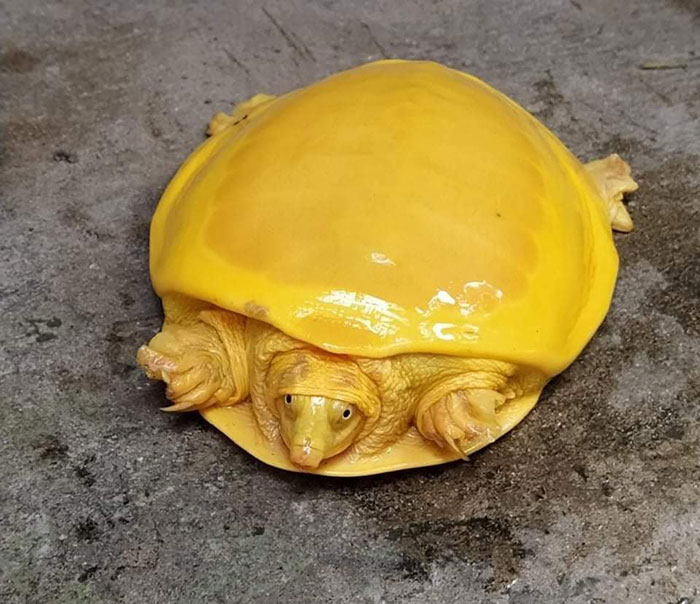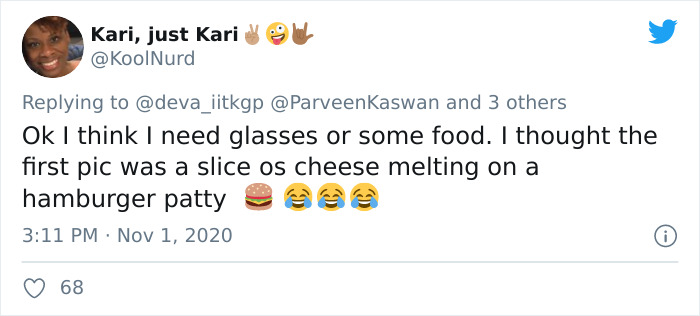
Extremely Rare Albino Turtle Was Found In India And It Looks Like A Slice Of Melted Cheese
This adorable bright yellow creature that got rescued in West Bengal, India is making headlines. Apparently, it is an albino Indian flapshell turtle, but people on the internet think it looks more like a slice of cheese.
The unusual turtle was stumbled upon by a farmer while he was working in his fields in the village of Sujanpur, in Odisha’s Balasore district. The farmer decided to bring the turtle home before handing it over to forest officials, who then contacted conservation experts. Talking to CNN, Siddhartha Pati, executive director at the Association for Biodiversity Conservation, said that it was the first time he had ever seen this kind of turtle.
More info: Twitter
A farmer in India discovered this extremely rare turtle, whose bright yellow color is due to albinism
Image credits: deva_iitkgp
The now-viral pictures of a bright yellow turtle were shared on Twitter on October 27. Naturally, people were more than surprised by its looks and started comparing it to cheese. But in fact, it’s an extremely rare albino flapshell turtle, which has been spotted in the wild only once before. This type of turtle can also be found in other South Asian countries like Pakistan, Sri Lanka, Nepal, Bangladesh, and Myanmar.
While the turtle itself is known as the Indian flapshell turtle
Image credits: deva_iitkgp
Siddhartha Pati, executive director at the Association for Biodiversity Conservation explained to the media that the vibrant yellow color of the creature is due to albinism. “It is a congenital disorder and it is characterized by complete or partial absence of tyrosine pigment,” he told CNN. It is a pigment that can be found in most reptiles. “Also, sometimes a mutation takes place in the gene sequence or there is a deficiency of tyrosine,” he continued.
The adorable yellow guy has now been released back into the wild
Image credits: deva_iitkgp
The experts believe that the discovered turtle is an adult, somewhere between one and a half and two years old. “This is the first time in Odisha and second time in India that an albino turtle has been found,” Siddhartha Pati told the media.
However, it was not the first yellow flapshell that has been rescued in India
Image credits: susantananda3
“One such aberration was recorded by locals in Sindh a few years back,” tweeted Susanta Nanda, who works at the Indian Forest Service, upon sharing a video and a picture of the rare turtle. “Mark the pink eyes, one indicative feature of albinism,” he added.
A rare yellow turtle was spotted & rescued in Balasore, Odisha yesterday.
Most probably it was an albino. One such aberration was recorded by locals in Sindh few years back. pic.twitter.com/ZHAN8bVccU
— Susanta Nanda IFS (@susantananda3) July 20, 2020
Here’s what people on Twitter had to say
Image credits: Glitched_Hero
Image credits: Z3r0Art
Image credits: KoolNurd
Image credits: Mengo329
Image credits: mycatkillsnazis
Image credits: TheRealDoom_Guy
12Kviews
Share on FacebookI love molecular biology and biochemistry!!! So this hurts...the article's science is wrong - the tyrosine itself isn't a pigment - it is the precursor in making the melanin pigment and the mutated gene mentioned has nothing to do with making tyrosine - that's an amino acid. The gene that is mutated usually expresses tyrosinase which is involved in the conversion.
Anyone who reads this just nod and pass by. I was just so happy to use a bit of my very narrow subject knowledge (without being drunk at a party.) :)
Load More Replies...Animals belong in the wild and all but wouldn't it be better to keep it? Albino animals are easily spotted by predators so the turtle wouldn't live long. Lots of people could care for a turtle and would love to have a rare albino one. I don't really know how that might affect the ecosystem and what-not however though.
I love molecular biology and biochemistry!!! So this hurts...the article's science is wrong - the tyrosine itself isn't a pigment - it is the precursor in making the melanin pigment and the mutated gene mentioned has nothing to do with making tyrosine - that's an amino acid. The gene that is mutated usually expresses tyrosinase which is involved in the conversion.
Anyone who reads this just nod and pass by. I was just so happy to use a bit of my very narrow subject knowledge (without being drunk at a party.) :)
Load More Replies...Animals belong in the wild and all but wouldn't it be better to keep it? Albino animals are easily spotted by predators so the turtle wouldn't live long. Lots of people could care for a turtle and would love to have a rare albino one. I don't really know how that might affect the ecosystem and what-not however though.

 Dark Mode
Dark Mode 

 No fees, cancel anytime
No fees, cancel anytime 




























































148
16